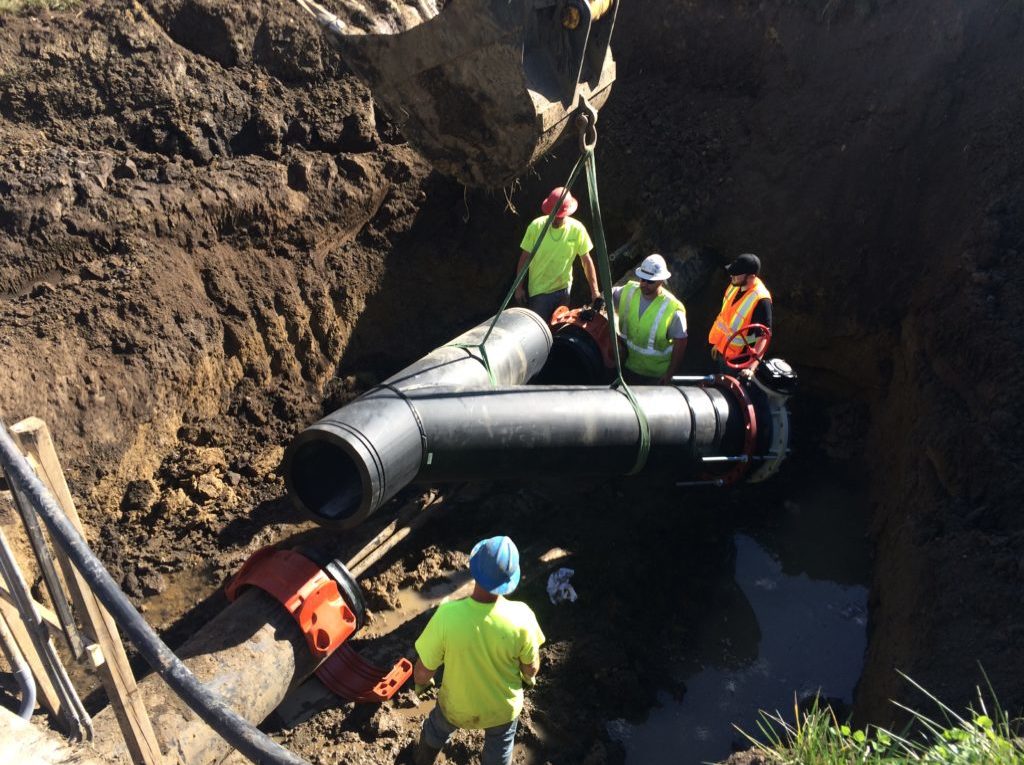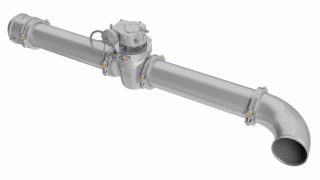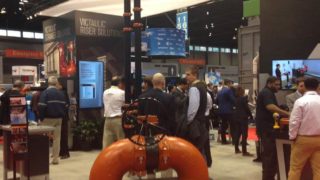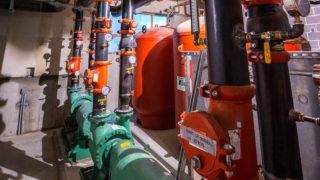Posted on March 23rd, 2022
- North American leaders successfully navigate challenging projects across U.S.
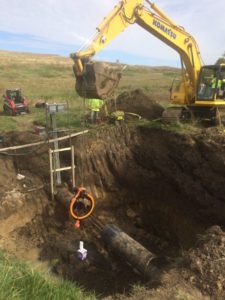
- Victaulic pipe joining solutions eliminate worker risks and help protect capital investments
Since 1919, Victaulic has developed innovative pipe joining solutions that improve safety, reduce risk and compress schedules, delivering real value to owners, engineers, contractors and maintenance personnel who have come to depend on them. Underground piping is one of the original applications for Victaulic couplings, dating back to the 1920s. The primary advantages of Victaulic flexible couplings are the expansion, contraction, and deflection capabilities available in combination with a self-restrained joint. Over time, these advantages led to many different opportunities, including Victaulic’s ongoing support to the industry’s top visionaries. So, when a leading North American landfill and waste management operation wanted to eliminate risk and reuse its methane gas, they turned to Victaulic to help make the impossible, possible.
Safety and Uptime Key to Operations
While landfill facilities naturally need ongoing maintenance to ensure smooth operations and EPA compliance, the presence of LFG and methane extraction systems heightens the risks. Safety is typically the number one consideration. Operators are always conscious of protecting workers and maintaining community support through a constant focus on safety and other factors such as minimizing smell and visibility issues.
Other factors for scheduled maintenance include downtime for energy production and equipment. Beyond the fact that an offline landfill means it is not producing energy, there is a limited amount of time to extract and use methane before its production value is lost. An additional factor for operators is the complex system equipment is designed to run 24/7. Taking it offline can create inherent problems, which creates the potential for extended downtime and expensive repairs. The challenges are ripe for a problem-solving company like Victaulic.
Finding New Solutions for Traditional Challenges
Greg Bannec, a Sales Manager for Victaulic with responsibility for Iowa and other Midwest states, knows required methane extraction maintenance at plants presents unique challenges. In one example, he says an operator needed to carefully cut tie-ins to an existing pipeline 10 feet below ground to facilitate a new line. These 24-inch lines feed the site’s cogeneration plant with a vacuum line, meaning there is no room for error with the joints. If external oxygen is sucked in, it can cause significant failure and damage the equipment, which can cause millions of dollars of cost.
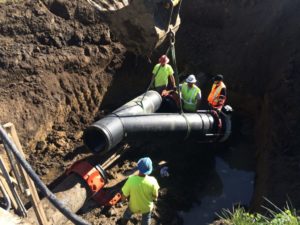 Bannec said the project manager could envision a lot of water filling in and knew there were smaller pipelines—an electrical line and a double-encapsulated line specifically— they needed to avoid cutting. Completing the project the traditional way, with the potential to create additional complexities and downtime risks, was not something this leading company wanted to continue doing. “This project is a great example of Victaulic solutions at work,” said Bannec.
Bannec said the project manager could envision a lot of water filling in and knew there were smaller pipelines—an electrical line and a double-encapsulated line specifically— they needed to avoid cutting. Completing the project the traditional way, with the potential to create additional complexities and downtime risks, was not something this leading company wanted to continue doing. “This project is a great example of Victaulic solutions at work,” said Bannec.
“The operator had been moving away from the traditional way of doing in-trench connections due to potential safety issues, cost issues, and past issues with Electro-Fusion.” According to Bannec, compliance also was paramount in this decision. “A big challenge for the operator was the reality that doing a traditional tie-in of the piping system would have taken the plant off-line resulting in considerably more downtime,” said Bannec. “This possibly would have created a compliance issue with the amount of time offline. Compliance drives everything operators do because there can be hefty fines.”
Realizing the critical need to explore alternatives to welding or electrofusion methods, Bannec said the entire project took a very fortunate turn for Victaulic. A pipe supplier (ISCO) was helping the operator determine how to join the pipes safely and quickly, and they brought the Victaulic coupling to the table as a potential option. “While the operator was familiar with Victaulic couplings, they didn’t know much about their install quality or Victaulic before this project.”
Bannec said the operator’s team did extensive research and was quickly impressed with what they learned. “They discovered that Victaulic was a leader in upstream oil & gas applications & life safety systems, including fire sprinkler systems, and that was very impressive to them,” said Bannec. “Our proven performance in safety settings for oil and gas, for example, provided the evidence they needed to feel confident we would be successful for them.”
Victaulic Perfectly Fits the Need – to a “Y”
According to Bannec, Victaulic had meaningful industry experience that would help solve the customers challenges. “Victaulic isn’t a foreign name to waste managers,” said Bannec. “Our products are used for various reasons in landfills and we already had a good reputation.”
Bannec says one difficulty with HDPE, whether being used in landfills, oil facilities, or municipal water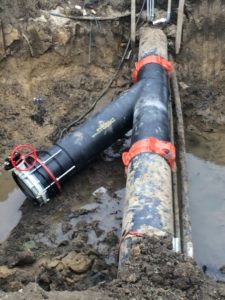 systems, is verifying if the joint has been fused properly. In-depth conversations led to understanding that Victaulic’s mechanical pipe joining solutions provided inherent advantages over traditional joining methods.
systems, is verifying if the joint has been fused properly. In-depth conversations led to understanding that Victaulic’s mechanical pipe joining solutions provided inherent advantages over traditional joining methods.
“Prior to speaking with Victaulic, the operator believed they only had two choices—welding or electrofusion,” said Bannec. “They could have welded in flange adapters and bolted everything back together, but the welding machine is large. It is an expensive machine that has to be lowered into the excavated ditch. It would have taken a lot of time to excavate, and there are safety issues with bracing.”
Bannec said an electrofusion coupling wasn’t a desired option because project managers had to make sure the pipe was perfectly round and free of obstructions such as dirt, debris, hydrocarbons, and pipe oxidation. This difficult process is precarious because managers don’t know if joints are done properly until the system is live, which can take several months. “Electrofusion is a last resort many operators don’t like to do,” said Bannec. “There are some inherent risks if the pipe isn’t prepped correctly. For example, you can create a fire affecting the entire landfill.
Ultimately, the operator believed that Victaulic’s HDPE solution provided a viable option to avoid exposing several thousand feet of pipe. Bannec says a decisive factor in their decision was Victaulic’s major joining advantage in being visually verifiable. “Project managers have to verify the integrity before it is fired up,” said Bannec. “Victaulic can be visually verified by metal-to-metal contact and 360-degree coupling engagement.”
The operator liked the fact that Victaulic’s system would eliminate the risk of sparks and the need for any cooldowns while providing additional flexibility advantages. “With the Victaulic system, the operator knew they would have the ability to rotate the fittings within the couplings for easy alignment with existing system pipe. This feature made it very easy to connect to the blower station without significant pipe routing changes. They would not have been able to do it otherwise.”
Victaulic Solution in Action
Once the operator decided to go with Victaulic solutions, Bannec’s team jumped into action. Cross and Y fittings were prepared in Victaulic’s Kansas City facility and shipped to the site. When delivered, the operator prepared the pipe ends using Victaulic’s intelligent HDPE grooving tool to cut and groove the existing pipe, 10’ below grade. “Minimal tool requirements allowed us to get in and not interfere because we only needed eight-to-12 inches of clearance,” said Bannec.
“With all the water and the strong likelihood of having methane present in the system, there were concerns about using a tool that could cause a spark and potential explosion. However, we were confident because our tool can run hydraulically and minimize any chance of a spark.”
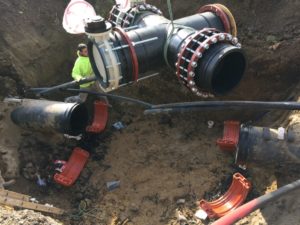 As with all projects, this site work presented new challenges once work began. According to Bannec, the operator discovered that one pipe section had a large scrape on the outside of the pipe, which can be a fail point for electrofusion, and the pipe was significantly out of round. However, the operator’s team was able to file and fill in the damaged section and then use a unique feature in Victaulic couplings that bring the pipe back into round. The next installation with cross fittings revealed a severely damaged pipe. Once again, the Victaulic tool with its spring-loaded blade was able to accommodate the ovality by enabling the operator to place the groove on the pipe accurately.
As with all projects, this site work presented new challenges once work began. According to Bannec, the operator discovered that one pipe section had a large scrape on the outside of the pipe, which can be a fail point for electrofusion, and the pipe was significantly out of round. However, the operator’s team was able to file and fill in the damaged section and then use a unique feature in Victaulic couplings that bring the pipe back into round. The next installation with cross fittings revealed a severely damaged pipe. Once again, the Victaulic tool with its spring-loaded blade was able to accommodate the ovality by enabling the operator to place the groove on the pipe accurately.
Realizing Extreme Advantage
In the end, the entire project was completed in one day. When the operator fired up the operations, everything worked perfectly. The experience was confirmation for the operator that they made the right decision and that Victaulic offered great value going forward. “They have become a company that buys and utilizes Victaulic,” said Bannec.“The operator has told us our couplings have not failed, and they know they are always going to be safe. It is one of the primary reasons they use Victaulic.”
Since the completion of this project, Bannec says Victaulic has done many similar projects with major landfill operators. Installations can range in size from 2″ through 36″ pipe. Victaulic also continues to use project learnings to expand into multiple different projects across industries.
